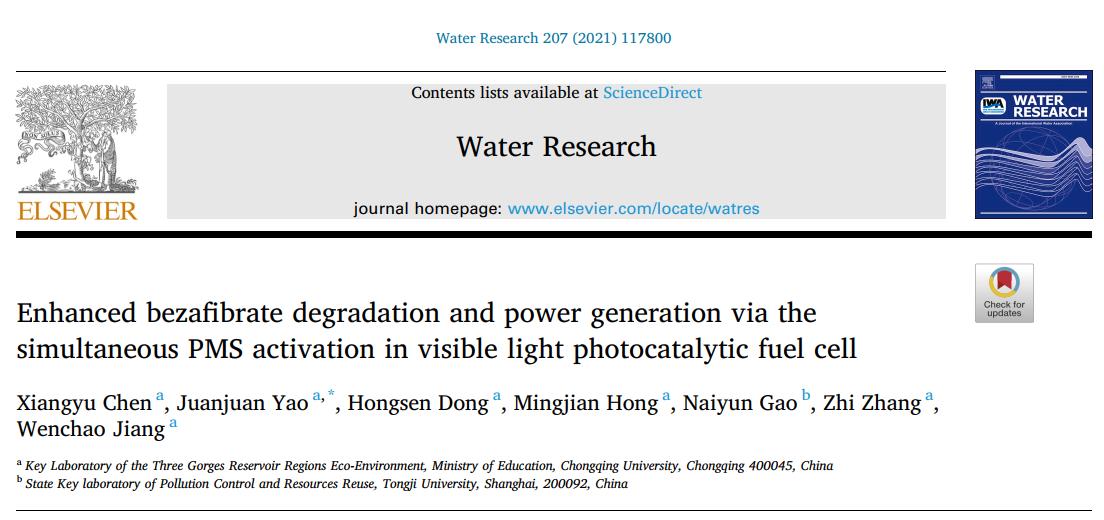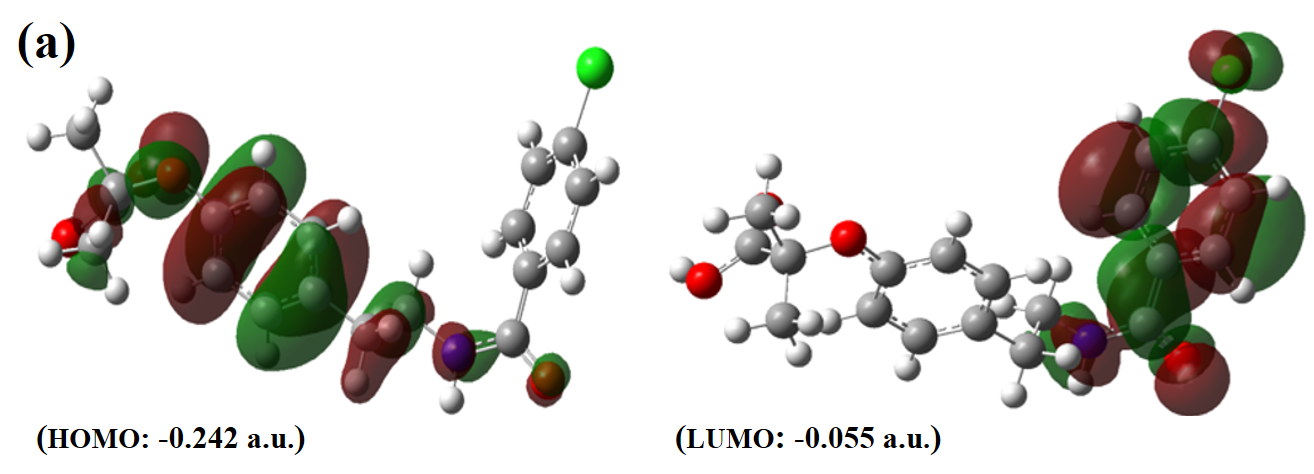2022-04-14 16:54:48
Professor Juanjuan Yao and Zhi Zhang’s group from the College of Environment and Ecology, has newly published a research paper named “Enhanced bezafibrate degradation and power generation via the simultaneous PMS activation in visible light photocatalytic fuel cell” inWater Research, a top academic journal in the field of environment. In this paper, a collaborative system by adding PMS into PFC under visible light (PFC/PMS/vis system) was established to enhance the separation of photoinduced charges, ROSs production and pollutant decomposition. A typical fibrates drugs, bezafibrate (BZF) was chosen for the execution of this project. The contribution of different reactive oxidizing species (ROSs) during reaction were evaluated by radicals quenching experiments and Electron spin resonance (EPR) analysis. Also the transformation products (TPs) of BZF and their degradation pathways were determined via LC-MS/MS together with quantum chemical calculation using frontier orbital theory. Moreover, the photo-electrochemical performance and power generation of this system were evaluated.
https://www.sciencedirect.com/science/article/pii/S0043135421009945?via%3Dihub

Graphic Abstract

Abstract
A collaborative system including peroxymonosulfate (PMS) activation in a photocatalytic fuel cell (PFC) with an BiOI/TiO2nanotube arrays p-n type heterojunction as photoanode under visible light (PFC(BiOI/TNA)/PMS/vis system) was established. A 4.6 times higher bezafibrate (BZF) degradation rate was achieved in this system compared with the single PFC(BiOI/TNA)/vis system. The radical quenching experiments revealed that the contribution of ROSs followed the order of1O2≈ h+>> •OH > SO4•->>O2•-. The EPR tests demonstrated that PMS addition enlarged the formation of1O2, •OH and SO4•-, but suppressed O2•-yield. Interestingly,1O2was further proved to dominantly originated from the priority reaction between positive photoinduced holes (h+) and negatively charged PMS. Besides, N2-purging tests and density functional theory calculation indicated that PMS probably reacted with residual photoinduced electron (e-) on the more negative conduction band (CB) of BiOI to form •OH and SO4•-, but competed with dissolved oxygen. Other e-transferred to the less negative CB of TNA through p-n junction will efficiently move to cathode through the external circuit. The greatly promoted power generation of PFC system was observed after PMS addition due to extra h+consumption and efficient e-separation and transfer. Besides, three possible pathways for BZF degradation were proposed including hydroxylation, fibrate chain substituent and amino bond fracture. This study can provide new insights into the mechanisms of PMS assisted photocatalysis and accompanying energy recovery.
Aims
This work aimed to (i) establish a collaborative system incorporating the PMS activation, photocatalysis and power generation; (ii) evaluate the enhanced pollutant degradation in water by the promoted reactive oxidizing species (ROS) production in the proposed reaction system; (iii) estimate the contribution of different ROS and their generation routes during reaction; (iv)determine the transformation products of pollutant and their degradation pathways ; (v) evaluate the photo-electrochemical performance and power generation of the proposed system.

Figure 1.Comparison of BZF degradation in different reactionsystems(Conditions: [BZF]0= 1 mg/L, [Na2SO4] = 0.01 M, [PMS]0= 0.25 mM, initial pH = 7.0)


Figure 2. (a) Isosurfaces and orbital energies of HOMO and LUMO of BZF (b) The degradation pathways of BZF in the PFC (BiOI/TNA)/PMS/vis system

Figure 3. Photo-electrochemical performance of different system: (a) electrochemical impedance spectroscopy (b) cyclic voltammograms curves (c) polarization curves (d) power density curves
Conclusion
This study demonstrated thatbezafibrate (BZF) which is recalcitrant to biodegradation and direct photodegradation, could be degraded efficiently in effluent through the combination of PFC system and PMS activation under visible light (PFC (BiOI/TNA)/PMS/vis system). A 4.6 times higher BZF degradation rate and 1.8 times higher maximum power generation was achieved in this system compared with the single PFC(BiOI/TNA)/vis system.The quencher tests revealed that1O2played a key role in BZF degradation, and reaction between PMS and h+was confirmed as the major pathway of1O2generation because the negative charged HSO5-was more inclined to interact with positive charged h+rather than e-. The EPR tests revealed that PMS addition could promote the generation of1O2, •OH and SO4•-, while O2•-could hardly be produced.
Additionally, N2-purging tests revealed that PMS and dissolved oxygen (DO) could compete for reacting with e-on themore negative conduction band of BiOI to form •OH and SO4•-, while other e-transferred to TNA through p-n junction will efficiently move to cathode through external circuit. Three BZF degradation pathways in this reaction system have also been proposed including hydroxylation, fibrate chain substituent and amino bond fracture. Notably, a much higher photo-electrochemical performance and power production were achieved in PFC (BiOI/TNA)/PMS/vis system, whichcould be attributed to the enlarged ROSs formation, extra h+consumption and efficient e-separation and transfer. All the results confirmed that the PFC (BiOI/TNA)/PMS/vis system proposed in this study is suitable for actual application with high efficiency and low energy consumption.